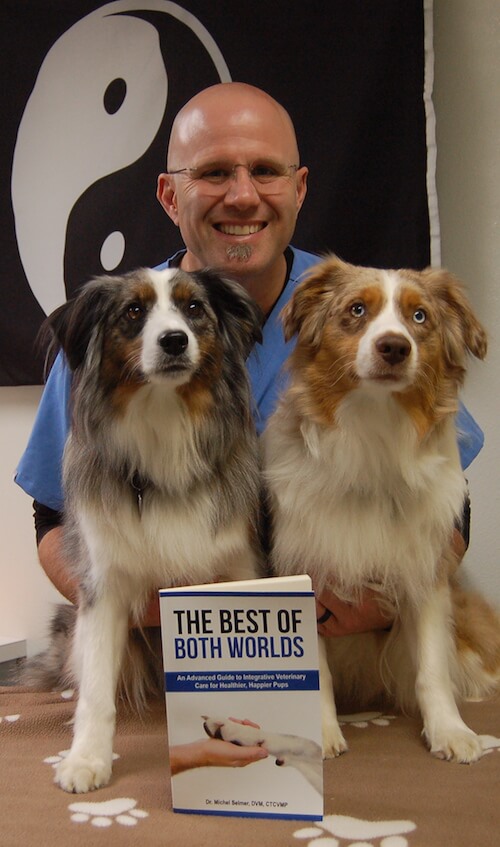Most dogs don’t like being left home alone, but sometimes they make leaving the house unbearable for their humans – but what’s even worse is knowing that they’re suffering.
Luckily, there are things we can do to help. We at iHeartDogs asked Dr. Michel Selmer, DVM, CTCVMP, about some ways to help out pups with separation anxiety. Also known as “The Caring Vet,” Dr. Selmer is a Certified Veterinary Food Therapist (CVFT) who uses principles from Traditional Chinese Veterinary Medicine (TCVM) to treat his patients.

What exactly is “separation anxiety”?
Dr. S: Separation anxiety describes dogs that are usually overly attached or dependent on family members. They become extremely anxious and show distress behaviors of vocalization, destruction, house-soiling or inactivity when separated from the owners.
Most dogs with separation anxiety try to remain close to their owners and become increasingly anxious the greater the separation. They may follow the owners from room to room and begin to display signs of anxiety as soon as the owners prepare to leave.
During departures or separations, they may begin to salivate or pant profusely, vocalize, eliminate, and refuse to eat, become destructive, or become quiet and withdrawn. Most often, these behaviors occur within about 20 minutes of the owner’s departure.
While the behavior typically occurs each and every time the owner leaves, it can happen on selected departures, such as workday departures, or when the owner leaves a second time after coming home from work. Dogs with separation anxiety are also often quite excited and aroused when the owner returns, jumping, whining, and/or running around for 5-15 minutes when they first come home.
Are there other reasons that my dog may engage in these behaviors?
Dr. S: Many dogs, especially puppies, enjoy chewing and engage in the behavior when they have nothing better to keep them occupied. House-soiling may be due to medical problems, leaving the dog alone for longer than it can control its bladder, or inadequate house-training. Vocalization may be due to territorial intrusion by strangers or other animals, and can be a rewarded behavior if the dog receives any form of attention when it vocalizes, or is rewarded by the stimulus leaving (like barking at the mailman).
Some dogs will attempt to escape or become extremely anxious when confined, so destructiveness or house-soiling when a dog is locked up in a crate, basement, or laundry room may be due to confinement or barrier anxiety and associated attempts at escape.
In addition, noise phobias such as a thunderstorm that passes through during the owner’s absence may lead to marked destructiveness, house-soiling, salivation, and vocalization. Old dogs with medical problems such as loss of hearing or sight, painful conditions, and cognitive dysfunction may become more anxious in general, and seek out the owner’s attention for security and relief. While giving attention to help calm your dog may seem to be the best alternative, this may greatly increase your dog’s need to be with you and around you at all times.
Related: The 10 Best Calming Supplements for Dogs

What can I do to help my dog’s separation anxiety?
Dr. S: So, before we talk about what steps we can take to help dogs with separation anxiety, I recommend you have your dog examined by your veterinarian to be sure it is not a medical problem that is causing the behavior change.
Once we have established that your dog truly has separation anxiety, here is where you can start:
Behavior modification – departure training. You may want to consult with a Certified Animal Behaviorist so you can properly take this on. Here are the common steps:
- Step One: Discourage Hyper-Attachment
- Step Two: Relaxation During Separation
- Step Three: Desensitization to Separation
If you come home to a mess, do not punish the dog for behavior demonstrated in fear. It will result in making your dog’s anxiety worse and make matters worse in the future.
Medical Management – Wouldn’t it be great if you could simply give your dog a pill and solve the problem? Unfortunately, training is the primary focus of solving separation anxiety and medication is an adjunct. Often the owner needs as much training as the dog.
However, medication can help. Clomipramine and Fluoxetine are two FDA-approved drugs for the treatment of separation anxiety. I have found Chinese Herbal therapies and acupuncture also be of tremendous help in situations of anxiety.
If you would like to pursue an “alternative” approach, you would need to see a veterinarian that is a Certified Traditional Chinese Veterinary Medicine Practitioner like me (wink, wink!) or you can visit this link to find one near you.

Thanks to Dr. Selmer for sharing his insight with us! If you want to learn more about taking a holistic approach to your pet’s healthcare, check out his book, The Best of Both Worlds: An Advanced Guide to Integrative Veterinary Care for Happier, Healthier Pups. You can also follow him on Facebook.
 Toledo, United States.
Toledo, United States.
